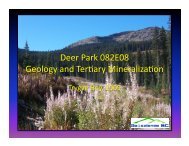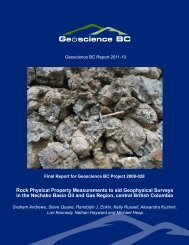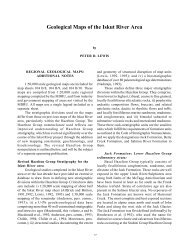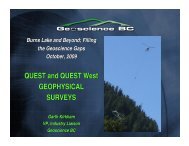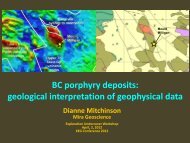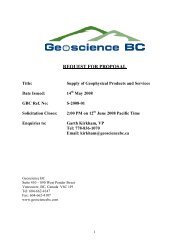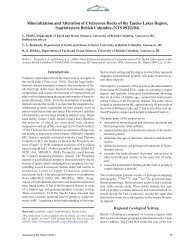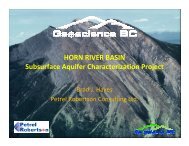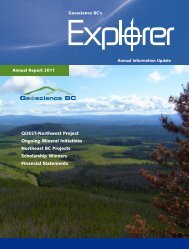Final Report - Geoscience BC
Final Report - Geoscience BC
Final Report - Geoscience BC
You also want an ePaper? Increase the reach of your titles
YUMPU automatically turns print PDFs into web optimized ePapers that Google loves.
surveys are commonly calibrated by ground spectral surveys on outcrops. Existing spectrallogging systems like Hylogger and hand-held short wave infrared instruments, PIMA II and ASDFieldspec, provide rock property readings that can be integrated with airborne gamma surveys.4.7. Seismology and Acoustic VelocityShallow 2D to 3D seismic surveys have been successfully employed for imaging complex faultstructures in the Athabasca basin and complex fold and fault structures that control goldmineralization (eg. Yilgarn, western Australia). Also the low acoustic velocity of massivesulphides lends these ore bodies to be detectable in cross-hole seismic surveys as documented atSudbury and Bathurst, New Brunswick. Faults and associated zones of rock weakness alsoappear as zones of low velocity in 2D and 3D surveys. Rock properties that are measured arerelative seismic velocity in meters per second (m s -1 ) and impedance (velocity + density) that is ameasure of reflectivity. Crystalline rocks tend to have high velocities and impedance comparedto sedimentary rocks. Plots of density versus seismic velocity are a useful way to differentiatedifferent lithologies to identify the best impedance contrasts for potential seismic surveys.Mineral Physical Properties: density–sus. sus. cross-plotRock Property ModellingFigure 1. Mineral physical properties: density susceptibility cross-plot8





